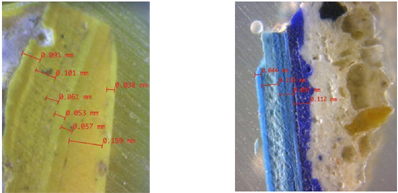Scientific Research
ICI has now successfully developed scientific investigation facilities that can enable a better understanding of the art materials, techniques and forms of deterioration. These techniques enable a more scientific and guided approach to conservation treatment. Also, using these techniques, the conservators at ICI are now moving from just treating the objects to creating greater understanding of the materials and techniques of the objects of art.
To begin with, cross-section and stratigraphic analysis of paint samples, dispersions of pigments with polarised microscopy along with flourescence study of pigments is being undertaken and a database is being compiled.
These standard examination methods provide very precise information about the complexity of materials that make up a painting or decorative finish. Tiny samples of paint are taken from discrete and representative areas and mounted in clear resin. Also prepared samples are observed under a binocular microscope at high magnification between 50x and 200x depending on the thickness of the examined layer.

Layers of yellow paint of varying thickness (10x magnification) and blue paint (4x magnification) applied on a wall support

Sample prepration and study under microscope
In spite of a world-class array of analytical instrumentation, Polarizing Light Microscopy (PLM) remains first and most important analytical technique for identifying individual particles through the microscope, even in complex mixtures. The polarizing microscope At ICI with reflected and transmitted darkfield, brightfield, and fluorescence microscopy is especially useful in the study of materials of paintings because with it one can readily identify crystalline materials that may look-alike, which include the majority of pigments. It also simplifies interpretation of the structure of a painting and measurement of the thickness and uniformity of each layer.
Pure vermilion pigment

Vermilion pigment under polarised microscopy









